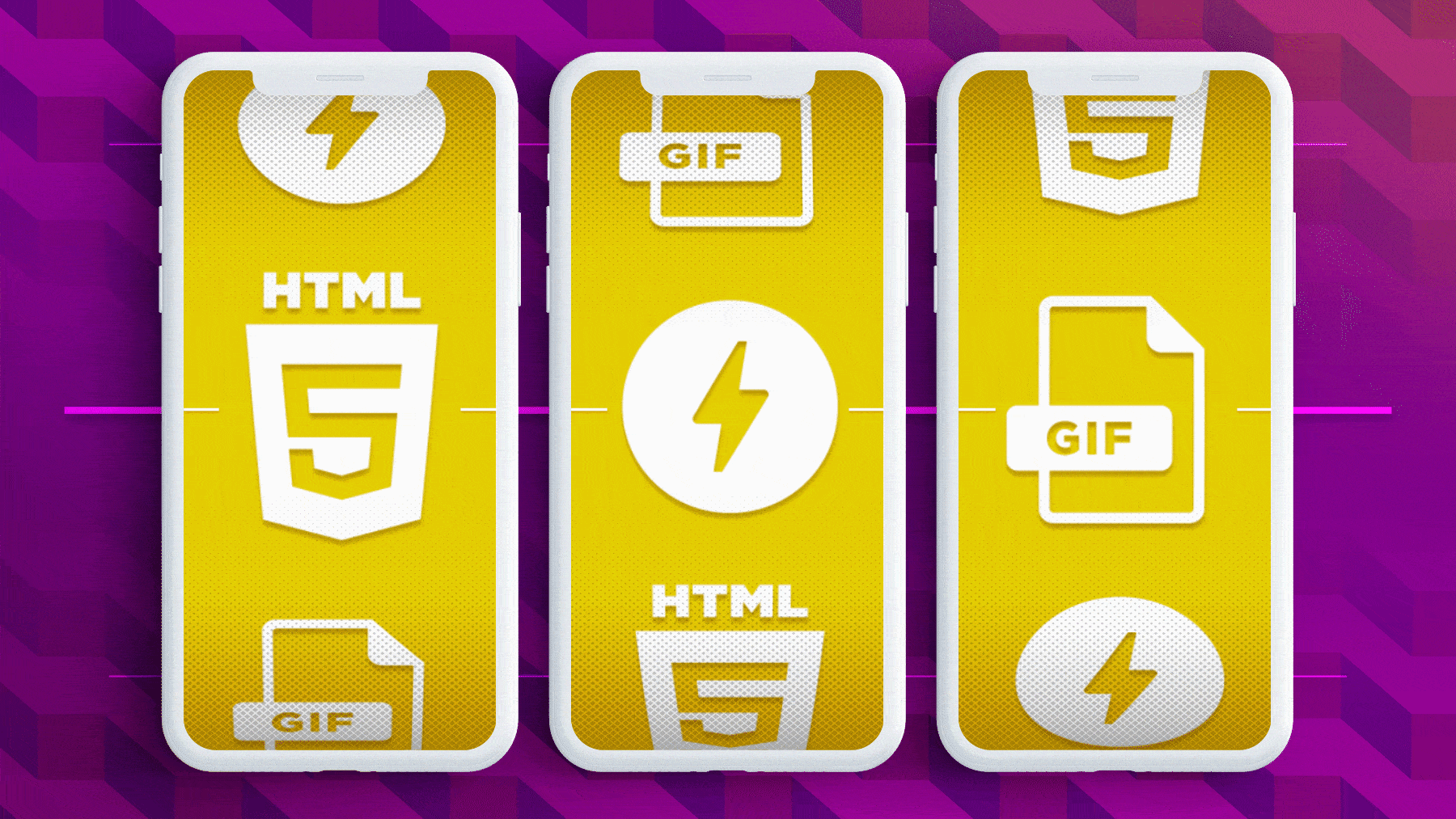
Often we’re asked what’s the best file format for display ads on Google Ads, Facebook Ads, or LinkedIn Ads? No matter what advertising network you choose, it’s fundamental for your display ads to be user-friendly and fast. We make the case for why you should abandon GIFs and optimize your advertising campaign’s ROI with HTML5 display ads.
Not ready to dive into the weeds of Display Ads? Start with the fundamentals of digital advertising and what tactics are worth implementing into your marketing strategy.
GIFs Display Ads
We don’t want to be completely unjust. GIFs did and still do have the right time and place. As browsers and devices started to phase out Flash capability, there was a need to produce a useful format to display quick, simple animations on a loop, thus GIFs became ubiquitous with banner ads. GIFs are now universally accepted by all advertising networks (as long as they don’t exceed the maximum size of 150kb). GIFs are beloved due to their ease of use and budget efficiency. However, the unanimous adoption of GIFs by digital marketers has kept this outdated technology overly prevalent. Consumers simply expect a better user experience when persuading them to click-through to your site, which is why HTML5 ads are better.
HTML5 Display Ads
HTML5 ads allow us to create more engaging, faster advertisements at a smaller size than GIF files. Where GIFs are limited by color palettes and compression, HTML5 ads account for scaling up or down without the consequences of pixelation. Additionally, the beauty of HTML5 is you can still export your ads to your desired sizes but since they are comprised of many files rather than just a static image they account for different browsers and device sizes and appear just the same. Besides being visually engaged, users can appreciate the dramatically faster load times because if your ad is too slow then you will miss that small opportunity to share your message.
HTML5 ads also provide support for more responsive and adaptive designs than GIF ads. For instance, a developer can export HTML5 ads to interact natively with touch capability, keeping your ads interactive and dynamic. Likewise, the dynamic code can even account for detecting a user’s location or local time and use that variable data to display within the ad. Now that’s dynamic! The only downside is HTML5 ads can vary depending on browsers and specifically the browser versions, which results in exhaustive testing on different browsers to make sure it works correctly. Rather than waste valuable budget on testing, move to the newest HTML5 ad format created specifically for optimal performance.
AMP HTML Display Ads
AMP HTML ads derive from the Accelerated Mobile Pages (AMP) project, which is an open-source initiative to enhance the web across devices. This initiative significantly impacts advertising networks. The AMP project now recommends configuring landing pages and display ads for AMP. This will equate to faster-loading ads and faster-loading landing pages. When you have seconds to make your pitch to interested customers, fast is better. Ditching static ads and GIFs will become a necessity to set yourself apart from the competition, and you’ll enjoy all these benefits from switching to AMP HTML ads:
Creative
AMP HTML ads are still flexible and dynamic while allowing for newer creative formats like carousel, parallax, and lightbox offered on various ad networks. With this versatility, you can still create rich media assets without having to sacrifice your creative vision.
File Size
AMP HTML ads remove excess JavaScript files to reduce file size and increase load speed.
Speed
With arbitrary JavaScript removed, ads load earlier in the page rendering process and before the viewer even sees your ad, thusly improving the visibility of your campaign.
Validation
An advertising agency has to be verified from Google to create and serve AMP HTML ads. This prevents malicious code from infiltrating HTML files and ensures a campaign remains safe.
Visibility
AMP HTML ads can run anywhere on the web and not just AMP web pages. Since Google is prioritizing AMP pages on SERP, it’s a sound idea to use AMP HTML vs. just HTML5; therefore, your ads are eligible to show up on Non-AMP and AMP pages on any device for greater visibility.
What Ad Format Should I Choose for My Next Campaign?
Some marketers would argue the choice comes down to personal preference. The benefits of newer display ad formats drastically improve the performance and user experience of your campaigns. Regardless of who you work with, it’s important to understand the impact of HTML5 ads and the ad inventory opportunities your campaign might be missing.


